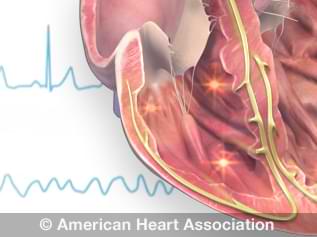Implanted Continuous Loop Cardiac Event Recorder
A cardiac event recorder is a battery-powered portable device that you control to tape-record your heart's electrical activity (ECG) when you have symptoms. There are two types of event recorders: a loop memory monitor and a symptom event monitor.
Cardiac event recorders and other devices that record your ECG as you go about your daily activities are also called ambulatory electrocardiographic monitors.
Quick facts:
- A cardiac event recorder makes a record of your electrocardiogram (ECG or EKG) when you have fast or slow heartbeats, or feel dizzy or like you want to faint. It can also be used to see how you respond to medicines.
- Some cardiac event recorders store your ECG in memory in the monitor. Your ECG can be sent by telephone to a receiving center or to your doctor.
- There are no risks when using a cardiac event recorder.
"I kept feeling this pounding in my chest. My doctor suggested I wear an event recorder, and soon I was put on medicine to control my fast heartbeat." Kay, age 61
Why do people need to use a cardiac event recorder?
Tests such as electrocardiograms let your doctor look at your heart's activity at rest and at one point in time. But abnormal heart rhythms and cardiac symptoms may come and go. The main purpose of an event monitor is to record your heart rate and rhythm during a symptom ("event"). They work only when a person turns on the device. Your doctor may recommend an event monitor when symptoms are infrequent – less than daily.
You may be asked to wear a cardiac event recorder if you have fast, slow or irregular heartbeats called arrhythmias.

Watch an animation of an arrhythmia.
Wearing the monitor may tell your doctor:
- If your medicines are working.
- If a pacemaker or an implantable cardioverter defibrillator (ICD) is working properly.
- Why you have symptoms such as chest pain, dizziness, faintness or the feeling that your heart is racing or skipping a beat.
- If your heart is getting enough oxygen to meet its needs.
What are the risks of cardiac event recorders?
Wearing a cardiac event recorder has no risks and causes no pain. However, if you wear electrode patches, the adhesive might irritate your skin. Any skin irritation disappears when the patches are removed.
What are the two types of event recorders?
The two types are:
- A looping memory monitor is a small device about the size of a pager that can be programmed to record your ECG for a period of time, such as 5 minutes. You must push a button to activate it, and it stores your ECG for the period before and during your symptoms. If you faint and push the button after you recover, it will record your ECG during the time you felt faint and passed out, and right after you pushed it.
- A symptom event monitor can be either a hand-held device or worn on your wrist. When you feel a symptom or irregular heartbeat, you place the monitor on your chest and activate a recording button. The back of this device has small metal discs that function as the electrodes. If the monitor is worn on a wrist, you press the button to record. This stores your ECG in memory. Unlike the looping memory monitor, these won't store your ECG before you activate it.
Both devices can send your ECG by telephone to a transmission or receiving center in the hospital, doctor's office or clinic. A staff person receives your ECG "tracing" and gives it to your doctor. If the tracing indicates an emergency, you will be asked to go to the emergency room.
How do I attach a cardiac event recorder?
Cardiac loop memory monitors have small disks (electrodes) that attach to your chest. Wires are attached from the electrodes to the device. To get a good ECG recording:
- Your skin should be free of oils and creams.
- You should clean your skin with alcohol or a gauze square and rub until the skin is slightly pink.
A technician at the receiving center will tell you exactly where to place the electrodes and how often to change them. You can wear the electrodes in the bath or shower.
Cardiac event recorders that you hold or wear on your wrist don't require electrodes on your chest. Instead, you place the device against your chest and press a recording button, or press the recording button on the wrist monitor when you have symptoms.
How do I send my ECG recordings by telephone?
The staff of the receiving center will teach you how to send your ECG over the telephone. This normally involves placing the telephone mouthpiece over the microphone on the front of the monitor. If you have irregular heartbeats on an ECG you send by phone, you will probably get a call from a staff person at the receiving center. This person will ask you about your symptoms, and may have you come in for an ECG or to see your doctor.
What happens after wearing a cardiac event recorder?
You may need to wear an event recorder for several days or up to a month. With several recordings, your doctor will be able to decide if your irregular heartbeats require more tests or treatment.
"I had my monitor for 4 weeks. It was so small I had no problem carrying it in my pocket." Jim, age 58
How can I learn more about cardiac event recorders?
Talk with your doctor. Here are some good questions to ask:
- How long do I need to wear the monitor?
- What will the results tell you about my heart?
- What other tests or treatments might I need when this test is over?
Source: https://www.heart.org/en/health-topics/arrhythmia/prevention--treatment-of-arrhythmia/cardiac-event-recorder